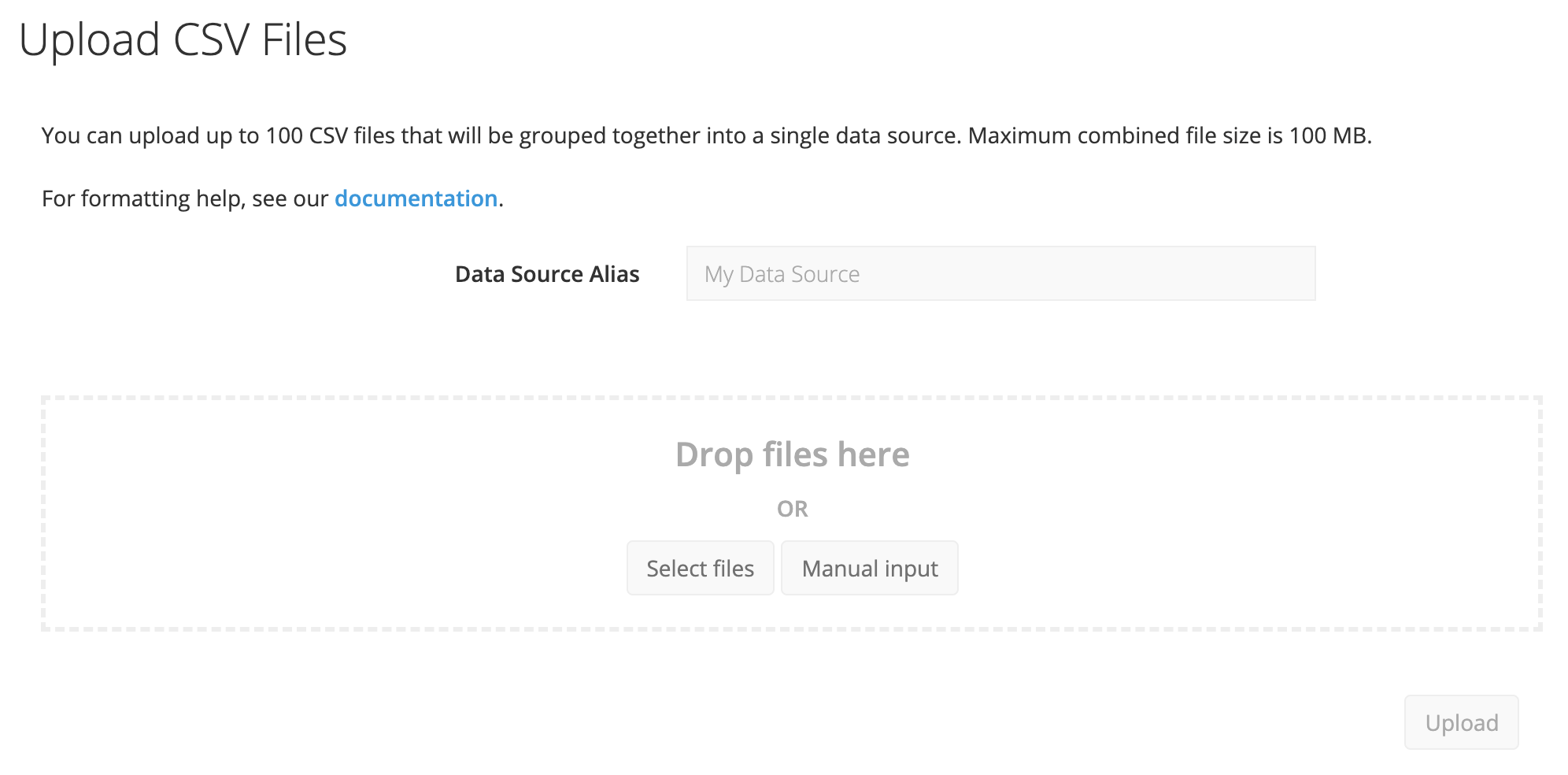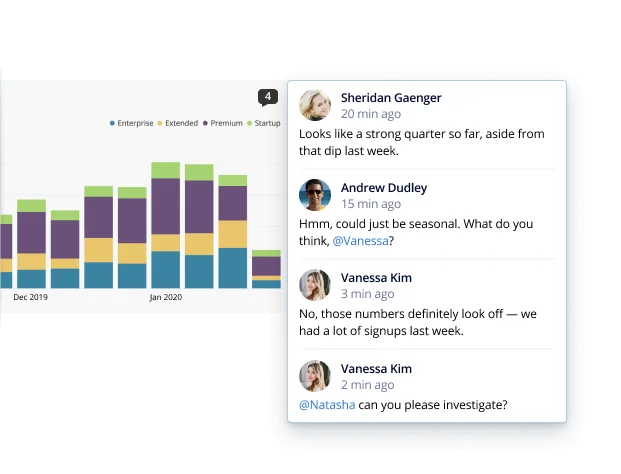What is a business intelligence platform? (And what does it do?)
Posted by: Sheridan Gaenger

A business intelligence (BI) platform is technology that helps businesses gather, understand, and visualize their data. It serves as the backbone of a company’s business intelligence strategy, which is how a company uses information to make better decisions.
But “better decisions” may be putting it a bit lightly. The purpose of BI platforms is to help companies compete in today’s data-saturated world by turning their data into a competitive advantage.
Why are business intelligence platforms important?
When implemented well, modern business intelligence platforms make your company’s data usable. Utilizing data more effectively has always been the core purpose of business intelligence, but BI platforms make this process much more efficient, resulting in a totally new relationship with data.
The term “business intelligence” was first used by Richard Millar Devens in his 1865 page-turner Cyclopædia of Commercial and Business Anecdotes to describe how a banker gained a competitive advantage by gathering and acting on information before other bankers could. Nowadays, companies manage a lot more data than 19th-century bankers, which makes it more difficult to achieve the “business intelligence” Devens described.
In 2016, the International Data Group (IDG) found that the average company managed 162.9 terabytes of data. Add that to Forrester’s finding that “between 60% and 73% of all data within an enterprise goes unused for analytics” and a pretty clear picture emerges:
Modern companies have a lot of data, but they can’t use it well.
Business intelligence platforms solve this problem by helping your company manage and understand what’s going on with those terabytes of data. From there, data takes on new importance by helping you
- make a better product by understanding customer behavior,
- serve your customers better by learning who they are and what they need, and
-
run a more efficient business by identifying potential issues before they become larger problems.
With the right BI platform, all of this can happen on the fly, which provides an advantage that no competitor can replicate, because your decisions are fast, accurate, and (most importantly) based on your company’s data — not anyone else’s.
What should a business intelligence platform do?
A business intelligence platform should help your company gather, understand, and visualize your data. The goal is to develop a data-driven culture that provides every employee with the ability to identify and act on insights.
1. Gather data
According to IDG, companies use an average of 400 data sources across their organization to feed their BI capabilities. BI platforms should gather data from all of those sources into one place in order to understand and visualize what’s happening.
When evaluating BI platforms, look for the ability to do the following:
Integrate many data sources. BI platforms should integrate multiple databases (/product/data-sources/), data warehouses, and CSV files. Here’s how that looks in Chartio:

- Clean data and manage data quality. According to BI-Survey.com, data quality management (DQ management) tops the list of BI trends gaining importance. Disparate data sets need to be made usable and intelligible, and BI platforms should help maintain that quality and speed up the process of cleaning poor-quality data.
- Blend data. Imported and cleaned data is ready to be blended together into one functioning data set. BI platforms should make it simple to blend data and gain a complete view across all your data sources.
- Ensure compliance and security. BI platforms should help you manage your data in a secure and compliant way. For instance, if you’re like Carelinx, who uses personal health information to match their customers with caregivers, you need a HIPAA-compliant BI platform.
2. Understand data
With mountains of data funneled into and accessible from one place, you can start to understand what it all means. A BI platform will give you the ability to sort through, organize, and query your data.
When evaluating BI platforms, look for the ability to do the following:
- Model and organize data. With all of your data centralized, you need an efficient way to organize it into relationships that work for your business. For instance, you can use features like data stores, which can be thought of as customized and curated mini-databases, to solve the specific needs of your marketing team.
- Query data. Every user of the BI platform should have an easy way of querying the data to get the answers they need quickly.
-
Perform exploratory data analysis (EDA). BI platforms should also allow power users, such as data analysts and scientists, to go as deep as they need to in order to test hypotheses. This includes features like drilldowns, data pipeline control, and data stores for frequently used transformations.
3. Visualize data
It’s not enough for your data to be understandable — it has to be usable. BI platforms should make it easy to collaborate and act on the insights your team identifies after you gather and understand it.
When evaluating BI platforms, look for the ability to do the following:
- Share your findings with dynamic dashboards. After modeling, cleaning, and querying your data, BI platforms should make it easy to create custom, dynamic dashboards to visualize what’s happening with your data in real time. Bonus points if you can manipulate and interact with these dashboards without coding knowledge.
Collaborate and communicate. Many people across your organization will use your BI platform, so the ability to collaborate and comment within the platform and even within dashboards is vitally important. Setting up custom alerts will also keep leaders, teams, and even the entire company informed of important developments. Here’s how that might work when analyzing sign-ups to your service:

Work with other technology. BI platforms are just one, albeit important, part of your tech stack, which means it needs to work well with all of the other tools you use. That includes where it gets data from (like we covered earlier) and where you send your dashboards to. For example, Chartio can embed interactive dashboards just about anywhere, including Salesforce, Confluence, and your website.
The result: Democratized data
The core result that a BI platform should produce for your organization is a culture of data democracy, where every employee has access to the data they need, when they need it, to make better decisions faster.
Managing the flow of data, from gathering to understanding to visualizing, has historically been managed by overstretched data and IT teams. BI platforms make these tasks easy (and even automatic, in some cases), so these teams can focus on more important tasks, like analysis and acting on insights.
The other benefit of making this data flow so easy to manage is that you don’t need a highly technical background to query data and create reports. Everyone, from C-level executives to marketing automation specialists to new sales reps, can use your data to make decisions and collaborate.
The impact of democratized data can be immediate and long-lasting. For example:
- Reddit was able to improve their sales dramatically by giving their sales team access to data about discussions happening in various subreddit communities.
- Munchery eliminated their data bottleneck, freeing up time, which allowed their data analysts to be proactive rather than reactive.
DataRobot has an 83% adoption rate of Chartio (their BI platform) among their employees, which drastically speeds up communication and collaboration. They estimate that they would need “10 more data analysts working full-time to be able to build & maintain the types of data analytics that Chartio allows us to do in every team in the company.”
With the right BI platform, democratized data can become your company’s competitive advantage by improving the efficiency of collaboration and quality decision-making.
How have business intelligence platforms evolved?
Business intelligence has made great strides in the last two decades, and it’s most evident in the two big changes ushered in by that BI platform.
Cloud-based business intelligence platforms
Business intelligence used to be manually installed on physical servers that your company owned and operated. Now, many BI platforms are cloud-based, meaning they’re hosted on the internet and can be accessed through web browsers. If you have a laptop, you can use business intelligence from anywhere you have an internet connection.
This shift to a cloud-based infrastructure coincided with BI platforms starting to use a subscription-based pricing model, like many other software as a service (SaaS) companies. Instead of paying once, you pay a much lower monthly or yearly price for up-to-date software.
Overall, the result was a lower bar of entry for companies, like scrappy new startups, that could never dream of their own BI solution. You no longer have to buy a server and hire a team to manage your BI solution. Instead, you can just sign up for a free trial and take it for a spin.
Self-service business intelligence platforms
A lower bar of entry means more people of all kinds get to use BI platforms for the first time. But not all of these new users have the technical know-how to fully leverage the features of many BI platforms. So, pressure has mounted to create user-friendly tools anyone can use.
Self-service is one of the next big challenges BI platforms need to tackle. BI Survey reports that self-service is the fifth most important BI trend, followed closely by similar trends, such as “data prep by business users.” Self-service BI is ranked so high for a good reason: if you want a culture democratized data, you need a BI platform that’s easy for everyone to use.
This opens the door for agile business intelligence, which is a BI system that can easily adapt to changes in your business and marketplace. Because all of your data is democratized and isn’t bottlenecked through one or two teams, your BI system becomes flexible and can evolve quickly to meet the changing needs of your teams.
If you’d like to learn more, we have a more in-depth guide on how to evaluate self-service business intelligence solutions.
Why you should consider a business intelligence platform
It’s never been easier to try a BI platform. The power of business intelligence is now attainable for businesses of all kinds, from the scrappiest of startups to Fortune 500 companies.
Combine that fact with the reality that business intelligence is now easier for anyone to use with self-service technology and there really is no downside to diving in. Results can be immediate and long-lasting, with most companies naturally creating a culture of democratized data, dramatically improving their sales, efficiency, and overall decision-making.
We recently made a list of some of the most well-known business intelligence platforms, explaining their strengths and weaknesses and describing who they’re best for. If you’re curious about business intelligence platforms, we encourage you to try Chartio for free.
